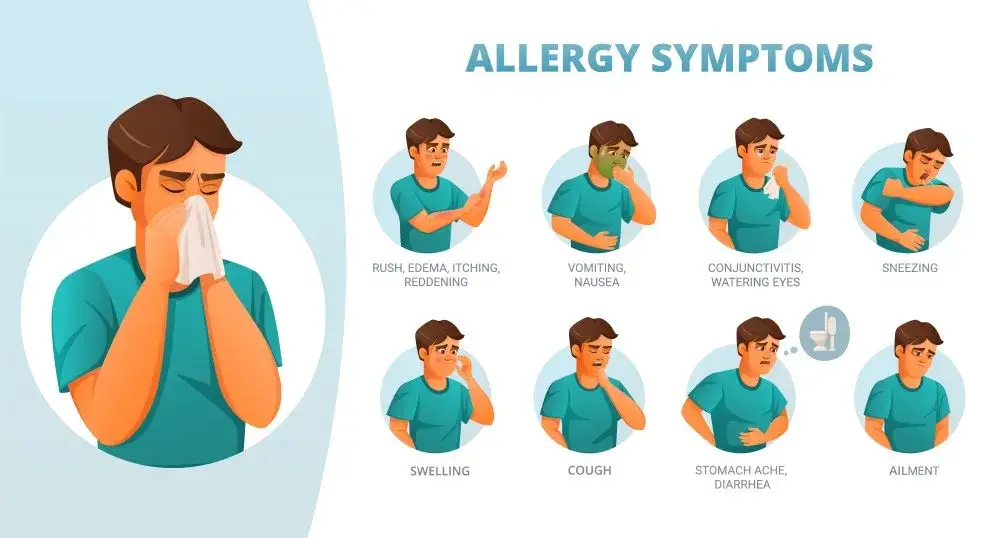Milk Allergies: An Overview
- Milk allergies is one of the most prevalent food allergies, in which the immune system has an exaggerated response to the proteins within milk when milk is consumed. The primary culprit is often cow’s milk, yet allergic reactions can also occur to other animal-derived milks such as goat or sheep milk.
- The manifestation of allergy to milk is the result of oversensitivity of the immune system, which is different from other food-related reactions such as milk protein intolerance in infants or lactose intolerance in older children and adults. It is important to note that a severe allergic reaction to milk can be life-threatening, with symptoms such as difficulty breathing requiring immediate medical attention through emergency services.
Table of Contents
Affected population:
- This allergy is indiscriminate in its effects, potentially affecting anyone of any age. However, its prevalence is notably higher in children under the age of 16, many of whom eventually outgrow the allergy. Both formula-fed and breast-fed babies can develop milk allergies.
Prevalence:
- In the United States, about 2% of children suffer from milk allergies, reflecting its relative uniformity in the population.
Effects on the body:
- The immune system’s response to milk allergens involves the production of immune globulin E (IgE) antibodies after the initial exposure to milk. These antibodies attach to mast cells in various body systems, causing the release of histamine when confronted with milk proteins. This histamine release is responsible for the manifestation of allergic symptoms, including potentially life-threatening reactions like anaphylaxis
- In addition, non-IgE reactions to milk are slower, sometimes taking up to 48 hours to appear. Although these reactions are not usually life-threatening, they can be the result of milk protein intolerance, especially in infants.
Allergy onset:
- The sudden development of dairy allergy remains unclear to health care providers and medical researchers, lacking precise explanations for its spontaneous occurrence.
Milk allergies symptoms:
- Dairy allergies typically begin shortly after consumption. Symptoms can vary in severity, with mild signs e.g.
- Umbrella
- Nausea or vomiting
- Abdominal pain
- diarrhea
- rash
- Itching
– Swelling or tingling of the throat, tongue and lips.
- Severe reactions can escalate to anaphylaxis, a potentially life-threatening condition that requires immediate intervention. Additional serious symptoms include:
- Tightness of the chest
- Shortness of breath (shortness of breath)
- Difficulty breathing
- Difficulty swallowing (dysphagia)
- Rash (contact dermatitis)
- Breathing
- Dizziness
- Low blood pressure (hypotension)
- Loss of consciousness (syncope)

Causes of milk allergies:
- An overactive response of the immune system to the proteins found in milk is the root cause of milk allergies. Milk contains two primary proteins:
- 1. Casein: Comprising about 80% of milk protein, this protein is formed during the curdling of milk and is also present in cheese and curd, lending milk its white color
- 2. Wheat: Comprising 20% of milk protein, whey is obtained from the liquid portion of curd milk.
- Allergy to one or both of these proteins.
Infectious nature:
- Milk allergies are not contagious and cannot be transmitted from one person to another.
Milk allergies confirmation:
- If you suspect a dairy allergy, it is important to consult a health care provider. They will refer you to an allergist, who will perform specific tests to diagnose a dairy allergy based on your symptoms.
Initial assessment:
- Before performing a dairy allergy test, an allergist may ask about the following:
- Family history of milk or other food allergies
- Early diagnosis of food allergies by health care providers
- Specific symptoms experienced
- Manage symptoms using medication
- Times of symptom onset
- Maintenance of food magazine
Diagnostic procedure:
- An allergist can use a variety of tests to confirm a dairy allergy:
Blood tests:
- A small amount of blood is drawn from a vein in your arm and sent to a lab. In the laboratory, milk proteins are added to assess IgE antibody levels. Results typically take a week or more.
Skin Prick (Scratch) Test:
- Your skin is exposed to small amounts of milk proteins. The allergist cleans the test area (usually your forearm or upper back) and uses a lancet to prick your skin with a milk protein solution. Another method is to put drops of milk protein solution on your skin and then lightly scratch the area. Positive and negative controls are used to assess responses, followed by observations after 15 minutes.
Graded Oral Challenges:
- If the medical history and test results do not align, a graded oral challenge may be recommended. This sequence involves increasing milk intake while monitoring for any allergic reactions. The challenge can stretch up to four hours.
Management and Treatment:
Milk allergies therapy:
- If you have a dairy allergy, the primary strategy to prevent a reaction is to strictly avoid dairy products. The FDA mandates clear labeling of common food allergens on food labels to help with identification and avoidance. Beware of products sharing processing facilities with dairy items, as cross-contamination is possible.
- Treatment may be unnecessary for children who often outgrow milk allergies. Consult an allergist to explore desensitizing treatments such as oral immunotherapy (OIT) where the child does not appear to have outgrown the allergy
Avoid foods and drinks:
- Individuals with dairy allergies should stay away from the following.
- All forms of milk (condensed, dried, evaporated, powdered)
- Milk from other mammals (goats, sheep)
- Butter, butter fat, butter oil, and artificial butter flavors
- Buttermilk
- cheese
- Cottage cheese and yogurt
- Custards, puddings, yoghurts
- Butter
- Acid cream
- Some individuals tolerate baked goods containing dairy; However, you should consult your health care provider before using such items. In rare instances, individuals with dairy allergies may react after consuming beef.
Getting vitamins and nutrients:
- Because milk is an important source of nutrients such as vitamin D and calcium, it is important for those with dairy allergies to find alternatives. Foods like spinach and broccoli can supplement these nutrients. Consultation with a registered dietitian ensures a well-balanced diet despite dietary restrictions.
Medications for dairy allergies:
- Diagnosis Individuals with dairy allergies should carry an epinephrine auto-injector, which is prescribed by a health care provider. This device quickly counteracts the symptoms of anaphylaxis. Understanding how to use it and keeping it accessible at all times is essential. Those with milk intolerance or non-IgE-mediated milk allergies generally do not need to be prescribed epinephrine.
Side Effects of Epinephrine Injection:
- Potential side effects of epinephrine injections include:
- anxiety
- Dizziness
- Dry mouth
- headache
- Sweating increases
- and vomiting from the stomach
- fatigue
- These wrong effects are normally transient and mild.
Beginning of relief:
- Epinephrine injections initiate immediate relief upon administration.
Outlook / Forecast:
- Living with a milk allergy, or having a child with one, presents challenges due to the variable nature of symptoms, which can range from mild to severe There is no surefire way to predict how the body will react to future exposures without past reactions. Even if previous reactions were mild, subsequent exposures could be severe. Individuals who have a history of severe reactions are at increased risk of experiencing a severe reaction again.
- Despite these challenges, a full life is possible with vigilance and caution. Health care providers can provide valuable resources, support groups, and guidance from dietitians to guide daily eating. Although many babies and young children outgrow milk allergies as their digestive systems mature, it is recommended to see an allergist annually for testing and treatments exist for specific cases of milk allergy.
Living with:
Self-care tips for managing dairy allergies:
- To effectively manage milk allergies:
- Always be mindful of food and drink options.
- Check nutrition labels carefully, as recipes and ingredients in products can change.
- Teach children with dairy allergies not to accept food from peers.
- When eating out, inform servers about allergies and ask about ingredients and food preparation methods.
- Include your food allergy details in your phone’s medical emergency settings.
- Consult a health care provider about preparing for possible allergic reactions and the possible need for an epinephrine auto-injector.
Receiving medical assistance:
- If you frequently experience milk allergy symptoms or notice symptoms developing after consuming milk, consult a health care provider on a regular basis.
- If symptoms of anaphylaxis manifest, seek immediate medical attention or contact emergency services.
Questions for Health Care Providers:
- During the consultation, consider asking health care providers:
- How can a milk allergy be properly diagnosed?
- When is it safe to introduce my child’s milk?
- What are the chances of my child growing out of a milk allergy?
- Are there support groups available for individuals or parents of children with dairy allergies?
- Can you recommend a qualified dietitian who specializes in food allergies?

Additional common questions:
Q. Are dairy allergies and lactose intolerance the same?
No, dairy allergy and lactose intolerance are significantly different.
– Lactose Intolerance: This condition refers to the body’s inability to digest lactose, the sugar present in many dairy products. Symptoms include bloating, cramping, and diarrhea after lactose ingestion. It is more common in adults than in infants and young children.
– Milk allergy: In contrast, milk allergy involves an exaggerated immune response to one or more milk proteins, often resulting in symptoms more serious than lactose intolerance and is more common in infants and young children.
Q. How is dairy intolerance tested?
The hydrogen breath test is the primary method for diagnosing milk intolerance. This test measures the level of hydrogen gas in your breath, as lactose intolerance causes abnormal hydrogen levels in the gut, which can be detected through this test.


